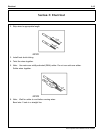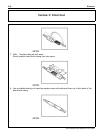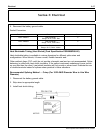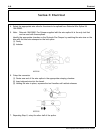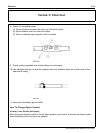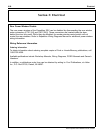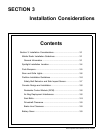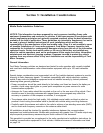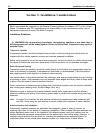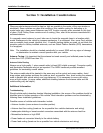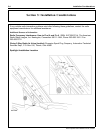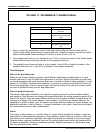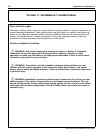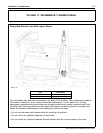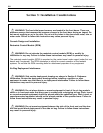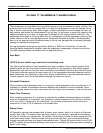
3-2 Installation Considerations
Section 3: Installation Considerations
Radio transmitters are regulated by the Federal Communications Commission (FCC) in the United
States. Compliance with FCC regulations is the responsibility of the manufacturer and/or user of
transmitter equipment and not Ford Motor Company.
Installation Guidelines
WARNING: Do not mount any transceiver, microphones, speakers or any other item in
the deployment path of the airbag system. Failure to follow these instructions may result in
personal injury.
Transceiver Location
A transceiver location should be selected that provides a solid mounting point which does not
interfere with the vehicle operator controls and provides adequate ventilation.
Before using screws to mount the transceiver equipment, be sure to check for vehicle wiring under
the carpet or behind the instrument panel which could be pinched, cut or otherwise damaged.
Radio Wiring and Routing
Transceiver power connections should be made directly to the battery and appropriately fused as
close to the battery as possible. A weatherproof fuse holder is recommended. Twist the positive
and negative power leads together to enhance noise immunity.
Use caution when routing wires between the passenger and engine compartments to avoid chafing
or pinching of wires. Use grommets over any exposed sharp edges and strain reliefs to keep wires
in place. Seal all holes to prevent moisture intrusion.
Route and secure all underhood wiring away from mechanical hazards such as exhaust manifolds
and moving parts (steering shaft, throttle linkage, fans, etc.).
Maintain as great a distance as possible between mobile radio power leads and the vehicle’s
electronic modules and wiring. Avoid running power leads in parallel with vehicle wiring over long
distances.
Note: On some Ford vehicles, the rear window contains the entertainment radio antennas (AM
and FM). Avoid using the rear window to mount mobile radio antennas in these vehicles.
Antenna Location and Installation
Permanently installed antennas are preferable over magnetic, glass or body lip mounts for
anything other than for low power or temporary installations. Most of these alternate antennas can
reflect significant power back at the feedpoint; this reflected power could then radiate from the
feedline inside the passenger compartment and be picked up by the vehicle wiring. However, a
magnetic-mount antenna is a good tool for checking the proposed fixed antenna location for
unwanted effects on the vehicle since antenna location is a major factor in these effects.
2010 Expedition SSV Modifiers Guide, 07/2009



